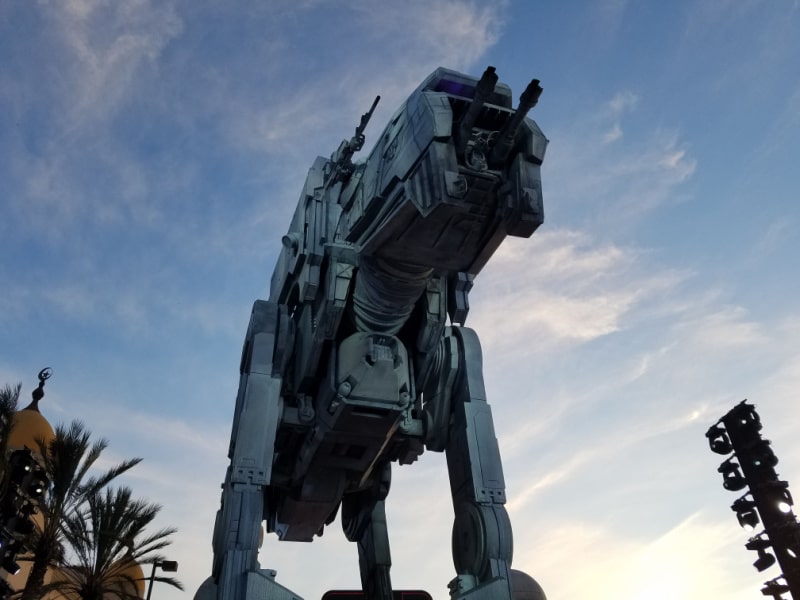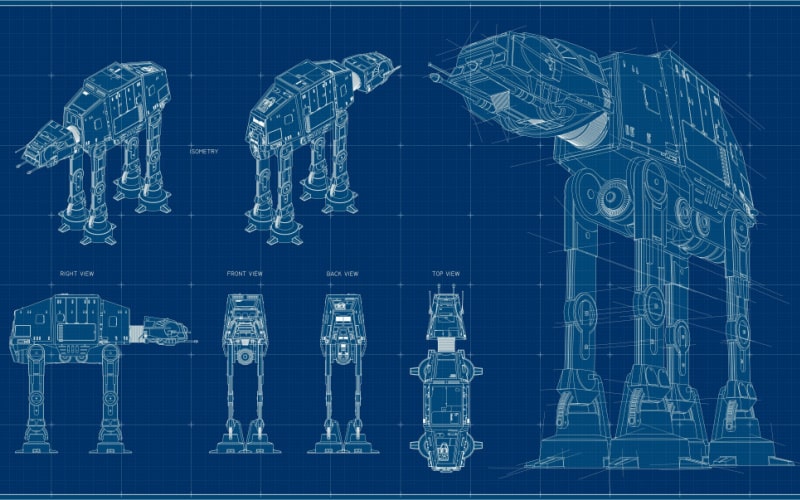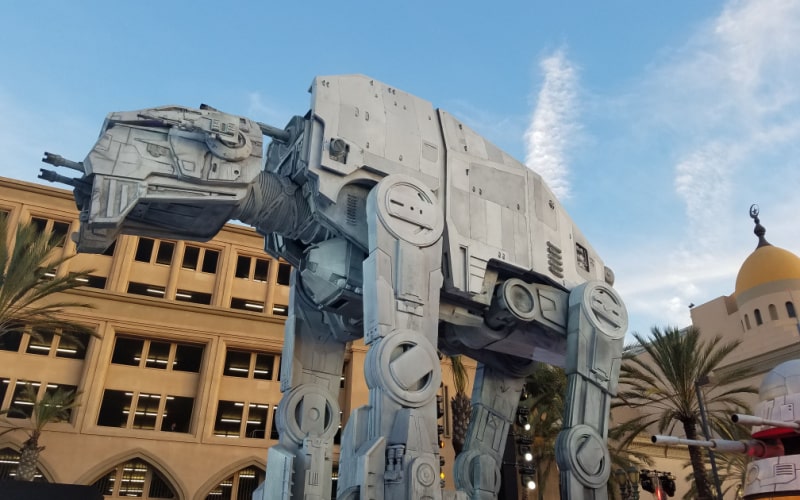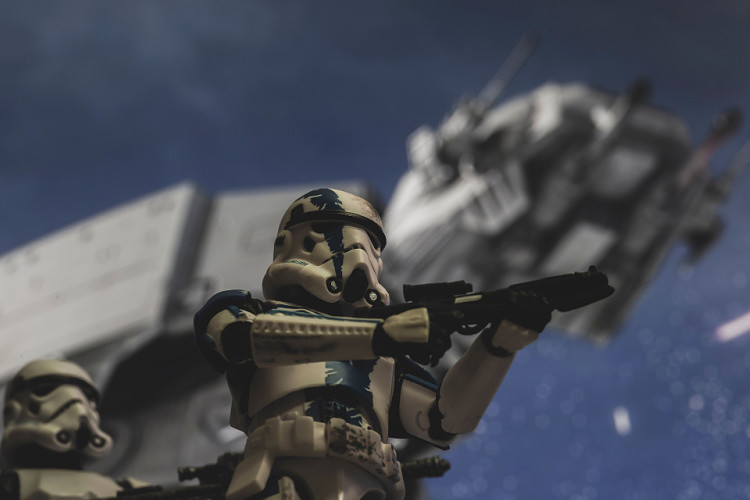All Terrain Armored Transports, or AT-AT Walkers, are massive combat vehicles used by the Empire. They first captured our attention in Star Wars Episode V: The Empire Strikes Back.
Audiences remember how these four-legged armored mammoths took center stage at the Battle of Hoth. Seemingly invincible, AT-AT Walkers were difficult to stop. Snowspeeders struggled to bring one down before imperial forces prevailed in this battle.
Why did the Empire use AT-AT Walkers? Despite some drawbacks, these war machines provided a military advantage, but the intimidation factor may be an even more important reason.
AT-AT Walkers on the Scene

As four-legged armored vehicles, AT-AT Walkers were used by Imperial ground forces to support their attacks. They were one of the most conspicuous examples of the Empire’s strength.
Although we first see AT-ATs in The Empire Strikes Back, they were designed and used during the Clone Wars. AT-ATs were made to replace the All Terrain Tactical Enforcer (AT-TE) used by the Grand Army of the Republic.
The AT-TE had six legs, laser cannon turrets, and a mass-driver cannon on top of the vehicle. At 20 meters (65 feet), AT-AT Walkers were built to be taller than their predecessors.
AT-ATs also were more heavily armored, stood on four legs, and had awe-inspiring firepower.
AT-AT Walkers displayed their power at the Battle of Hoth. Rebels in snowspeeders and ground troops tried to use blasters against the AT-ATs, but the armor was too strong.
They next used harpoon guns and managed to bring down one Walker by tangling its legs.
Yet, the Empire’s attack continued with an AT-AT blasting out the Rebels’ main power generator that provided the shield that protected the base. Soon afterward, imperial forces under Darth Vader stormed Echo Base.
Where Did the AT-AT Design Originate?

Although AT-AT Walkers were first deployed during the Clone Wars, they have other origins.
AT-ATs have real-life designs behind them. As one article reveals, Italian inventors in the 1930s designed a mechanical horse called the Iron Dobbin.
The Iron Dobbin had steel-pipe legs that were meant to teach horse riding to youngsters involved in the Italian Fascist Youth Movement.
Even closer to resembling an AT-AT walker was a General Electric machine from the 1960s. As the above article reveals, the Walking Truck was 12 feet tall and designed as a cargo carrier.
In the same decade, artist Syd Mead designed a four-legged vehicle for US Steel Corporation. Like the AT-AT, Mead’s steel vehicle was all-terrain and was even pictured moving through the snow in a company brochure.
Mead’s design is closely related to that of the AT-AT Walker. H.G. Wells provides another origin for the AT-AT Walker.
George Lucas based his concept for the AT-AT on H.G. Wells’s novel, The War of the Worlds. Wells’ 1898 novel depicted towering, spindly-legged Martian machines. These war machines invaded a planet in a way that Lucas showed in Star Wars.
As Lucas explains, his goal was to make the Battle of Hoth unique, and he did not want to use traditional military vehicles like tanks.
These “giant walking machines” were essential to creating a dramatic battle scene that would rival the original Star Wars Death Star battle.
Ironically, the actual AT-AT models were quite small. Some AT-AT models could be held in the production crew’s hands.
Animators based the AT-AT’s movements on elephants–they even brought a real one into the studio and recorded how it walked!
What Are the Advantages and Disadvantages of AT-ATs?
As a gigantic war machine, the AT-AT has the advantage of towering over its opponents on the battlefield. In a ground battle, the Imperial Walker’s strength is comparable to the power of a Star Destroyer in space.
With armor that is nearly invincible, AT-ATs can advance against opposing forces with ease. AT-ATs can operate in different terrains like snow. They can transport troops, and commanders can monitor the battle from above.
This versatility is supported by the fact that AT-AT Walker feet are equipped with toes. These toes provide flexibility and balance.
The AT-AT Walker’s firepower is also an advantage. They are equipped with two heavy laser cannons and two medium-blaster cannons. With their 20-meter height, AT-ATs can pour down fire on the enemy.
There is also the psychological element to consider. The fear that an AT-AT Walker instills may be its biggest advantage. For example, the sheer size and destructive capability overwhelmed the Rebels on Hoth.
Yet, the AT-ATs have disadvantages too. Even though Imperial forces overwhelmed the Rebels on Hoth, this battle also showed that the AT-AT could be tipped over by wrapping a cable around its legs.
The problem here is that AT-ATs have a high center of gravity that allows for them to be toppled over. Further, as fans have also pointed out, AT-ATs are slower than modern tanks.
Some of these disadvantages were revealed in Return of the Jedi during the Battle of Endor. AT-ATs did transport troops to Endor, but because of the forest undergrowth, the Empire relied on All-Terrain Scout Transports (AT-STs) in the battle.
As lighter-weight and two-legged machines, AT-STs are smaller and even more versatile machines than AT-ATs, demonstrating that the latter is not always the best battle option.
AT-ATs may have ground-level stability, but they had problems with tackling forest terrain or going up steep inclines. In addition, AT-ATs were quite visible from far away. The element of surprise with the attack and deployment of troops was gone.
Did AT-AT Walkers Help or Hurt the Empire?

Given these shortcomings, we might conclude that the AT-AT Walkers hindered the Empire. But that conclusion would be incorrect.
AT-ATs played a crucial role in the victory at Hoth and capture of Echo base. We should remember that at the end of The Empire Strikes Back, the Rebellion was in disarray and the Empire seemed on the rise.
With the rise of the First Order, we also saw that AT-AT Walkers continued to be used. This Walker was updated with enhanced armor, light turbolasers on the side of the head, and a boarding ramp located under the machine’s chin.
This updated AT-AT was put to use by Kylo Ren and deployed at the Battle of Crait. Yet, at this battle, the AT-ATs mainly served to escort the more advanced All Terrain MegaCaliber Six (AT-M6s).
Known as Gorilla Walkers, the AT-M6s reflected that the First Order had shifted its emphasis to a more mobile artillery walker. This machine was larger than the AT-AT and had a single, six-turbolaser cannon on its back.
Still, these improvements reflect that the First Order had drawn on the AT-AT’s original design for its war with the Resistance.
Like the previous AT-AT, the AT-M6 was not only tactically awe-inspiring. This new machine also had a significant psychological effect. Both the AT-AT and the AT-M6 were massive, towering vehicles that scared away forces by their mere presence.
Even with a mixed record of practical-battle elements for the AT-AT, this psychological component underscores that the AT-AT ultimately did serve the Empire’s purposes.
Although the AT-AT may not have always been the best option militarily, it did support the larger aims of the Empire–to bring control and order to the galaxy.
AT-AT Terror
AT-AT Walkers did contribute to the Empire’s goals both in the Battle of Hoth and in the larger scheme of galactic control. Their impressive size and features help explain the advantage they offered to the Empire.
Yet, it may be the psychological impact that defined AT-AT power the most and proved to be more significant than the tactical advantage. In the end, AT-ATs were instruments of terror.

